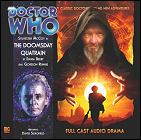 The Doctor, still flying a TARDIS that has turned black, visits the time of the seer Nostradamus, only to discover alien researchers operating in close proximity, studying Nostradamus’ precognitive ability. When yet another alien expedition appears – this time a platoon of brutish aliens called the Phalanx of Kro – the Doctor begins to suspect that Nostradamus isn’t really Nostradamus, and the TARDIS hasn’t really landed on Earth. But the famed clairvoyant and all of the people around him are alive, even if they’re not human. When the Doctor seems unable to convince any of the beings responsible for creating this scenario and its occupants that they have the right to survive rather than being shut down like a simulation, he takes it upon himself to save the world… as has been prophesied by Nostradamus himself.
The Doctor, still flying a TARDIS that has turned black, visits the time of the seer Nostradamus, only to discover alien researchers operating in close proximity, studying Nostradamus’ precognitive ability. When yet another alien expedition appears – this time a platoon of brutish aliens called the Phalanx of Kro – the Doctor begins to suspect that Nostradamus isn’t really Nostradamus, and the TARDIS hasn’t really landed on Earth. But the famed clairvoyant and all of the people around him are alive, even if they’re not human. When the Doctor seems unable to convince any of the beings responsible for creating this scenario and its occupants that they have the right to survive rather than being shut down like a simulation, he takes it upon himself to save the world… as has been prophesied by Nostradamus himself.
written by Emma Beeby and Gordon Rennie
directed by Ken Bentley
music by Andy HardwickCast: Sylvester McCoy (The Doctor), David Schofield (Nostradamus / Conclave Leader), John Banks (Brors / Captain of the Guard / Bernardo), Caroline Keiff (Garilund / Computer Voice), Derek Carlyle (Kren / Second Nuncio), Nicholas Chambers (Larrett / Milo / First Nuncio)
Timeline: after Robophobia and before Project: Nirvana and Black And White; possibly simultaneous with Protect And Survive
LogBook entry and TheatEar review by Earl Green
Review: An clever version of the “setting/time period isn’t where/when you think it is” chestnut, The Doomsday Quatrain at least deals with a specific setting and central character that hasn’t already been touched by the Doctor Who mythos, other than that throwaway mention that Madame Nostradamus had knitted the fourth Doctor’s scarf. And just in case that’s a deal-breaker, the story then neatly sidesteps all possible future complications by revealing that it isn’t really Nostradamus at all. Handy, that.
The Kro are a fun adversary, though they’re a bit dense (if the licensing barriers ever came down enough for us to hear the Judoon try to reel in the Kro, that might be a pay-per-view event). Since the story isn’t dealing with the real Nostradamus, common sense and science can safely be thrown out the window so the story can have a bit of fun with the idea of Nostradamus without having to worry about bumping into reality at any two points. Drop in an ominous end-of-story zinger that’s the audio seventh Doctor’s equivalent of “he will knock four times”, and it’s a fun little story.
